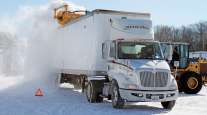Editorial: Are We There Yet?
Getting from Point A to Point B is sometimes harder than it sounds. Ask folks in Atlanta, Alabama, New Orleans and points in between, who got stuck last week on frozen highways or in snowbound airports.
For people who live and work where snow and ice are commonplace in winter, the paralysis and hundreds of traffic accidents may seem like a joking matter. But the cold reality is that towns, cities and states that rarely see snow and ice don’t have the equipment to deal with it; they don’t invest in snowplows, salt and sand spreaders or de-icing facilities because, most of the time, that equipment would sit in a shed somewhere gathering dust while taxpayers fumed over paying for expensive, unused gear.
That’s the dilemma that state and municipal leaders face in the South. But it’s also part of their job. They need to explain to irate commuters, truckers and editorial writers that taxpayers must make a choice between keeping their costs low or keeping their roads passable.
On a much larger scale, it’s similar to the choice facing American taxpayers right now, as Congress prepares to renew transportation funding legislation. Or not.
The last time Congress looked at the difficult task of telling taxpayers that they must spend money if they want passable highways, bridges that don’t fall down, or ports that can handle the ever-growing volume of exports and imports, it basically went and hid in the closet for 2½ years, hoping someone else would solve the tough problem of fixing America’s transportation infrastructure.
President Obama called for more infrastructure spending in his State of the Union address to Congress last week. That’s good . . . as far as it goes, but the president didn’t go far enough.
With Congress perennially shy about raising taxes ahead of an election — and there’s always an election around the corner, isn’t there? — it’s going to take a strong push from the White House and a lot of political courage on Capitol Hill to get the job done.
There’s just no way to rebuild our highways, bridges and ports without spending a lot of money. While Congress might hope to finally find the late Sen. Russell Long’s famous “man behind the tree” to tax, the simplest, most direct and efficient way to get from Point A to Point B is to raise taxes on motor fuels.



